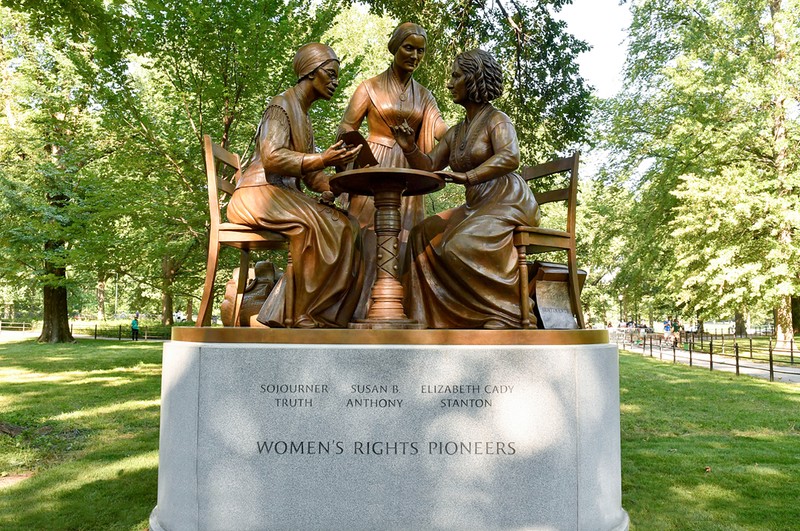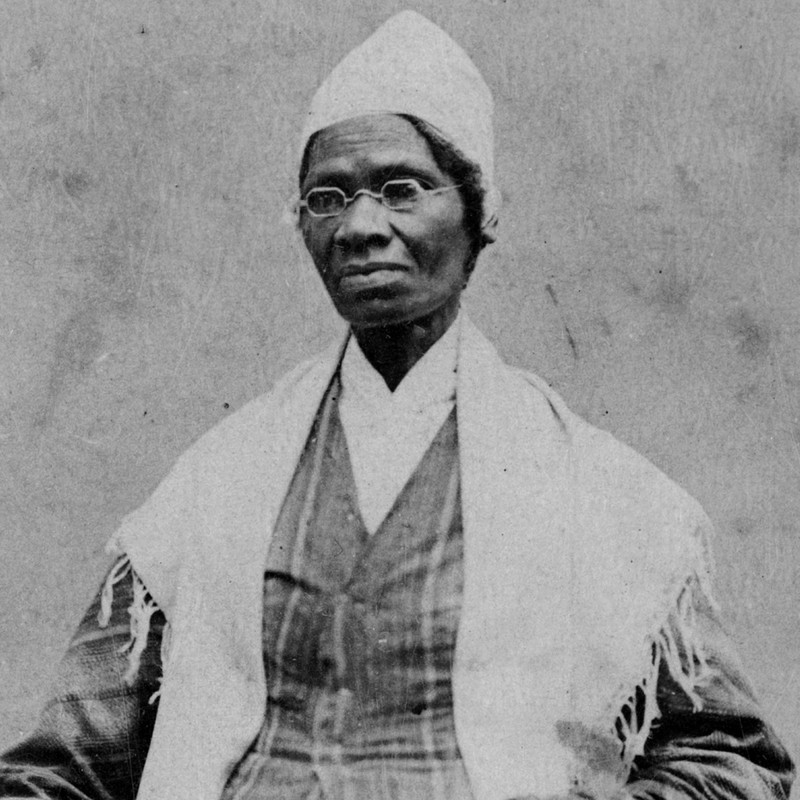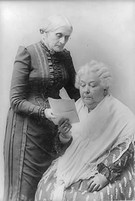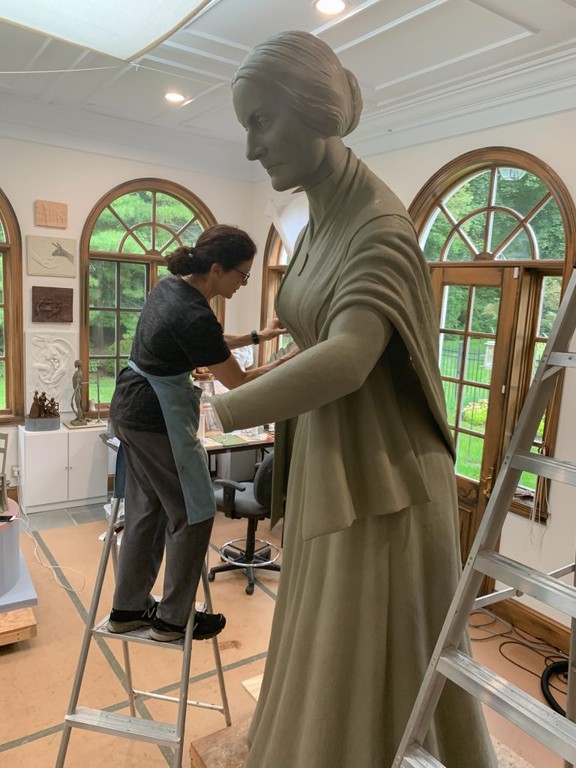Women's Rights Pioneers Monument
Introduction
Text-to-speech Audio
Images
Women's Rights Pioneers Monument

Sojourner Truth (1797-1883)

Susan B. Anthony (1820-1906) (left) and Elizabeth Cady Stanton (1815-1902) (right)

Renowned sculptor Meredith Bergmann working on the monument in her studio

Backstory and Context
Text-to-speech Audio
Born enslaved as Isabella Baumfree in Ulster County, New York in 1797, Sojourner Truth escaped from her owner in 1827 and fled to a nearby abolitionist family, which bought her freedom. The following year, she moved to New York City, where she worked for a minister, converted to Christianity, and participated in the religious revivals of the Second Great Awakening. In 1843, believing that God had called her to travel and preach the truth to the people, she changed her name to Sojourner Truth and became an itinerant preacher. During her travels, Truth met prominent abolitionists William Lloyd Garrison and Frederick Douglass. The former’s organization encouraged her to begin delivering anti-slavery speeches across the country. Truth also met Elizabeth Cady Stanton and Susan B. Anthony, which inspired her to fight for women’s rights, including the right to vote. In 1851, at a women’s rights convention in Akron, Ohio, she delivered her famous “Ain’t I a Woman?” speech, in which she spoke out against gender and racial inequality. During the Civil War, Truth encouraged enlistments in the Union Army and gathered supplies to send to Black troops. During Reconstruction, she received an invitation to the White House, worked with the Freedmen’s Bureau, and spoke out against racial segregation in the South. Truth died in Michigan in 1883.
Born into a family of privilege in Johnstown, New York in 1815, Elizabeth Cady Stanton received a top-notch formal education during her early years. In 1840, she married abolitionist lecturer, Henry Stanton. Like her husband, she became active in the antislavery movement and, in the process, met many prominent abolitionists, such as William Lloyd Garrison and the Grimke sisters. Infuriated by the exclusion of women at the World Anti-Slavery Convention in London in 1840, Stanton along with fellow abolitionist Lucretia Mott decided to organize a women’s rights convention in the United States, which later became the Seneca Falls Convention in 1848. At the meeting, some of those in attendance signed the “Declaration of Sentiments,” of which Stanton was the principal author. Taking inspiration from the Declaration of Independence, the document asserted that all men and women are created equal and ought to have equal rights, including the right to vote. In 1851, Stanton met Susan B. Anthony and the two commenced a friendship and professional partnership that would span decades. During the Civil War, Stanton supported the ratification of the Thirteenth Amendment, which abolished slavery. Along with Anthony, she founded the National Woman Suffrage Association in 1869, which advocated for a constitutional amendment giving women the right to vote. She also wrote for the organization’s newspaper, The Revolution. In October 1902, Stanton died in New York City.
Born into a Quaker family in Adams, Massachusetts in 1820, Susan B. Anthony learned at a young age the values of her faith. Among those was equality, an idea which would inform her later activism. While living with her family in upstate New York, Anthony met prominent abolitionists William Lloyd Garrison and Frederick Douglass. Both men, in fact, were friends of her father and were often guests in the family’s home. Inspired by their work, Anthony became an abolitionist and began traveling the country delivering antislavery speeches. In 1851, she met Elizabeth Cady Stanton and began a friendship and professional partnership that would influence the women’s rights movement in the United States for the remainder of the nineteenth century. With Stanton, she founded the National Woman Suffrage Association in 1869. Three years later, in 1872, Anthony was arrested for voting, an incident which brought the women’s suffrage movement national attention. Throughout the remainder of her life, she tirelessly advocated for women’s suffrage, traveling the country giving speeches, collecting signatures for petitions, and lobbying Congress for a women’s suffrage amendment to the Constitution. Anthony died in New York in 1906.
In 2014, the all-volunteer non-profit group Monumental Women was founded with the goal of creating the first monument in Central Park to honor actual women, as opposed to fictional female characters. Over the course of several years, the organization raised over $1.5 million in private donations. It commissioned renowned sculptor Meredith Bergmann to create the monument. Unveiled in August 2020, the centennial of the ratification of the Nineteenth Amendment to the U.S. Constitution, the monument consists of three over-life-sized bronze likenesses of Sojourner Truth, Elizabeth Cady Stanton, and Susan B. Anthony on an elongated oval granite pedestal. The Women’s Rights Pioneers Monument was the first to be added to the park since 1965.
Sources
"About Monumental Women." Monumental Women/The Statue Fund. Web. 27 October 2020 <https://monumentalwomen.org/about/>.
Hayward, Nancy. "Susan B. Anthony. National Women's History Museum. 2018. Web. 27 October 2020 <https://www.womenshistory.org/education-resources/biographies/susan-b-anthony>.
Michals, Debra. "Elizabeth Cady Stanton." National Women's History Museum. 2017. Web. 27 October 2020 <https://www.womenshistory.org/education-resources/biographies/elizabeth-cady-stanton>.
Ibid. "Sojourner Truth." National Women's History Museum. 2015. Web. 27 October 2020 <https://www.womenshistory.org/education-resources/biographies/sojourner-truth>.
"Women's Rights Pioneers Monument." Central Park Conservancy. Web. 27 October 2020 <https://www.centralparknyc.org/locations/womens-rights-pioneers-monument>.
https://monumentalwomen.org
https://www.biography.com/activist/sojourner-truth
https://parks.ny.gov/historic-preservation/heritage-trails/womens-heritage/default.aspx
https://monumentalwomen.org/sculptors-page/
